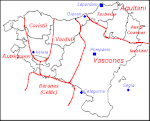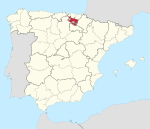Veleia was a Roman town in Hispania, now located in the province of Álava, Basque Autonomous Community, Spain. The site is located in the municipality of Iruña de Oca, 10 kilometers west of Vitoria. The town was an important station on the Roman road ab Asturica Burdigalam that ran parallel to the coast of the Bay of Biscay. At its apogee, the city could have been inhabited by some five to ten thousand people, and apparently went through different cycles of prosperity and decline into the Early Middle Ages until it was finally abandoned.
It has been argued (e.g. J.M.Lacarra) that the location of Iruña is actually the Victoriacum founded by Liuvigild in his campaigns against the Vascones (581), since only a very small portion of the actual town has been unearthed so far by archaeologists.
The archaeological site of Iruña-Veleia is the most important from the Roman period in the Basque Country. It was alleged to contain the oldest known texts written in the Basque language as well as, allegedly, the oldest representation of the crucifixion of Jesus found to date, but later it was said that the findings were forgeries. Other authors favored their genuinely ancient provenance, in agreement with the stratigraphic dating performed by the archaeologists who made the discoveries.
In June 2020 the archaeologist who had made the claims, Eliseo Gil, was pronounced guilty of fraud and connivance with an external collaborator in presenting a false report. The court ruled that the pieces had been altered “by himself or through third persons with contemporary incisions to simulate that they contained inscriptions of the same ancient age as the objects in which they were engraved and that they possessed a historical and cultural value of which they were devoid.”. The verdict was appealed by Gil, but the appeal was dismissed. Subsequently, Gil filed an appeal to the Constitutional Court. In parallel to the court developments, a scholarly controversy on the authenticity of the inscriptions is taking place.







